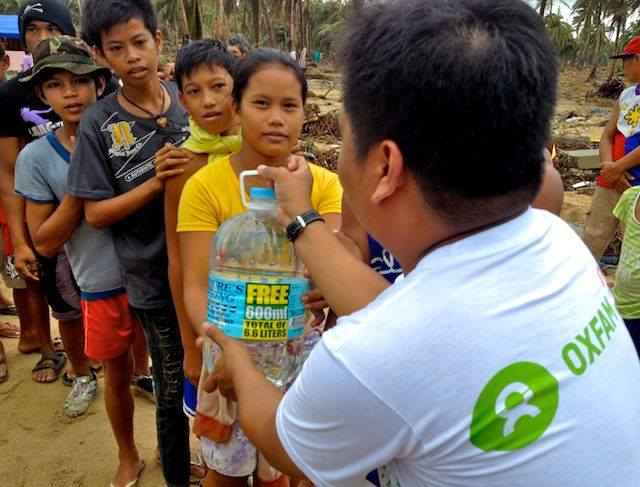Yesterday we traveled north, hugging the beautiful eastern coast line of the island of Cebu. As we made our way in a four hour drive to the northern most tip of the island the villages, tourist resorts and tranquil blue sea we saw seemed almost incongruous with what we knew lay ahead.
As we came closer to the area where the typhoon had made its impact, things began to change. There were trees uprooted, electricity poles tipping perilously at an angle, through front yards of small houses, sugar cane crops looking like untidy haircuts and coconut trees snapped off at the half way mark.
These random images became more concentrated the further north we went. There is erratic destruction, not unlike what we saw in the bushfires in Australia, where a small grass hut survived and counter-intuitively a more substantial structure was destroyed. Increasingly we saw kids along the side of the roads.
Yards became a tumble of structures that had been partly flattened, electricity poles down, wires draped over front fences and propped above the road trees felled by powerful winds – and again in an illustration of resilience and survival – lines of washing drying in the wind amongst the muddle and tangle of destruction. We saw twisted girders that once framed up factories, half felled houses, gas stations that were flattened but the pumps still operating, and pervasively the lines of washing – normality between the rubble.
Incredibly the area is beginning to rebuild already. We saw men on their roofs, mending gaping holes. We saw the start of cleaning up the felled trees, with neat piles of firewood on the side of the road in some places. At one stage of the journey we saw linesmen atop the electricity poles, carefully threading and stretching the lines to a position of safety.
The journey to the north of Cebu was to help with a distribution of aid to the small village of PayPay (pronounced Pie Pie), where we had taken 800 hygiene packs for families in the area. This is a very poor village that relies on fishing, small scale farmers and labourers for their survival. When we arrived at the distribution centre, which was once a national high school, there were hundreds of families waiting patiently in district groups, with volunteering village leaders assisting our team with registration and disbursement of the goods, sheltering under umbrellas from what turned out to be a very hot sun, and a very humid day.
The hygiene packs have soap, toothpaste, toothbrushes, plastics, mats, blankets and so on – basic needs to get them through. There was a very upbeat introduction of the kit by one of our Oxfam workers and much clapping and smiling in the crowd. And then a very orderly and systematic lining up to wait to be registered and to receive the packs.
Stories of survival
We spoke to Annie, 31, who had three children – an eight-month-old boy and two girls, aged three and two. Her house was lost in the typhoon. We asked her what she needed and she said simply, ‘everything’. Everything had gone. Not surprisingly, Annie is struggling to comprehend the enormity of what happened and says they desperately need assistance.
“We are going to need help from other countries,” she said. “After the typhoon, we feel aftershock. I don’t know how to react, how to overcome this kind of damage. On that day, all the rooftops are blown away, all the houses are damaged. The rooftop of my house is blown away. Our kitchen is broken, the floor is damaged. My children are shocked, we are in fear, we need help. We need food, water, clothes, slippers, underwear, shampoo, forks, spoons, a kettle.” She said the Oxfam hygiene kits would be very useful for her family. “It’s a very great help for us because we have nothing. Everything in our house is blown away.”
We spoke to Victor whose family had been affected and who wanted some help. We spoke to Evangeline whose house had fallen off its stand in the cyclone and who lost her 40 year old son – “I buried him last week,” she said. Yet despite the adversity faced by these people, they waved us off with a smile and a thank you – a positive and astonishingly resilient village.
As aid flows more quickly now to those who need it most we must begin to work with the people affected by this disaster to plan for the longer term and jointly determine what we can do to help these incredibly resilient people rebuild and repair their homes and their lives in a way that ensures their independence and respects their own ways and their unwavering pride.
By Helen Szoke – Chief Executive of Oxfam Australia
Donate today to help us reach 500,000 people in desperate need of emergency aid after the devastation of Typhoon Haiyan.




